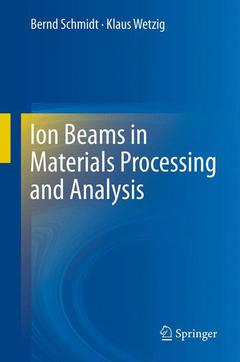Description
Ion Beams in Materials Processing and Analysis, 2013
Authors: Schmidt Bernd, Wetzig Klaus
Language: English
Keywords
Approximative price 189.89 €
In Print (Delivery period: 15 days).
Add to cartPublication date: 11-2014
418 p. · 15.5x23.5 cm · Paperback
Approximative price 189.89 €
In Print (Delivery period: 15 days).
Add to cartPublication date: 12-2012
418 p. · 15.5x23.5 cm · Hardback
Description
/li>Contents
/li>Biography
/li>Comment
/li>
Preface
1. Introduction
2. Fundamentals
3. Ion Beam Technology
3.1 Principles of Ion Accelerators
3.1.1 Low Energy Ion Accelerators (Ion Implanters)
3.1.2 High Energy Ion Accelerators
3.2 Ion Sources
3.2.1 Hot Filament (Hot Cathode) Ion Sources
3.2.2 Cold Cathode Ion Source (Penning Ion Source)
3.2.3 High Frequency (RF) Ion Source
3.2.4 Duoplasmatron Ion Source
3.2.5 Ion Sources for Electrostatic Accelerators
3.2.6 Cesium Sputtering Ion Sources
3.2.7 Field-Evaporation or Liquid Metal Ion Sources (LMIS)
3.2.8 Beam Extraction from Ion Sources
3.3 Ion Acceleration
3.4 Ion Beam Handling
3.4.1 Ion Mass Separation
3.4.2 Ion Beam Focusing
3.4.3 Ion Beam Scanning
3.4.4 Ion Beam Current Measurement
3.4.5 Ion Detection (Detectors, Spectrometers)
3.5 Ion Implantation Systems
3.5.1 Common Low Energy Beam Line Implanters
3.5.2 Specialized Low Energy Beam Line Implanters
3.5.3 High Energy Beam Line Implanters
3.5.4 Plasma Based Ion Implanters (PBII)
3.6 Electrostatic Ion Accelerator Systems
3.6.1 Single-Stage Electrostatic Accelerators
3.6.2 Two-Stage Electrostatic Accelerators
3.7 Focused Ion Beam Systems
3.7.1 Low Energy Focused Ion Beams
3.7.2 High Energy Focused Ion Beams
4. Materials Processing
4.1 Ion Irradiation and Damage Annealing
4.2 Ion Implantation into Semiconductors
4.2.1 Ion Implantation into Silicon
4.2.1.1 Advanced CMOS Technology
4.2.1.2 Defect Engineering and Epi-Layer Replacing in High Power Devices
4.2.1.3 Silicon Detector and Sensor Technology
4.2.2 Ion Implantation into Germanium
4.2.3 Ion Implantation into Compound Semiconductors
4.2.3.1 III-V Semiconductors
4.2.3.2 Group III-Nitride Materials
4.2.3.3 Silicon Carbide
4.3 Ion Beam Synthesis of New Phases in Solids
4.3.1 Buried Insulating Layers in Silcon
4.3.2 Ion Beam Synthesized Silicide Layers
4.3.3 Ion Beam Synthesis of Nanocrystals in Insulators
4.4 Ion Beam Mixing of Interfaces
4.5 Ion Beam Slicing of Thin Layers (Smart-Cut for SOI and Solar Cells)
4.6 Ion Beam Erosion, Sputtering and Surface Patterning (Ripples)
4.7 Ion Beam Shaping of Nanomaterials
4.8 Ion Beam Processing of other Materials (Metals, Insulators, Polymers...)
4.8.1 Ion Implantation of Metals
4.8.2 Ion Implantation into Polymers
4.8.3 Ion Implantation into Insulating Optical Materials
5. Ion Beam Preparation of Materials
5.1 Displacement of Target Atoms by Sputtering
5.2 Effects on Sputtering Yield
5.2.1 Ion Energy and Ion Atomic Number
5.2.2 Ion Incident Direction
5.2.3 Selective Sputtering
5.2.4 Targert Material
5.2.5 Preferential Sputtering
5.3 Ion Beam Induced Target Modifications
5.3.1 Ion Beam Cleaning and Etching
5.3.2 Ion Beam Induced Material Deposition
5.3.3 Ion Beam Depth Profiling
5.3.4 Ion Beam Cutting
5.3.5 Ion Beam Thinning
5.4 Focus Ion Beam (FIB) Preparation
5.4.1 FIB Induced Cross Section Preparation
5.4.2 FIB Induced Thin Film Preparation
5.4.3 Limiting Effects at FIB Preparation
6. Ion Beam Analysis of Materials
6.1 Ion- Solid State Interactions
6.2 Ion Beam Analytical Techniques – a Survey
6.3 Ion Beam Scattering Techniques
6.3.1 Rutherford Backscattering (RBS)
6.3.2 Medium Energy Ion Scattering (MEIS)
6.3.3 Elastic Recoil Detection Analysis (ERDA)
6.4 Ion Beam Induced Photon Emission
6.4.1 Particle Induced X-Ray Emission (PIXE)
6.4.2 Particle Induced γ-Ray Emission (PIGE)
6.5 Nuclear Reaction Analysis (NRA)
6.6 Ion Beam Induced Light and Electron Emission
6.7 Secondary Ion Emission
6.7.1 Dynamic Secondary Ion Mass Spectrometry (Dynamic SIMS)
6.7.2 Static Secondary Ion Mass Spectrometry (Static SIMS)
6.7.3 Sputtered Neutral Particle Mass Spectrometry (SNMS)
6.8 Ion Beam Imaging Techniques
6.8.1 Field Ion Microscopy
6.8.2 Ion Microscopy with Stationary Beam
6.8.3 Scanning Ion Microscopy
7. Special Ion Beam Applications in Materials Analysis Problems
7.1 Functional Thin Films and Layers
7.1.1 Direct Study of Diffusion Pricesses in Amorphous Thin Layer Systems
7.1.2 Nanoanalytical Investigations of Tunnelmagnetoresistance Layers
7.2 Ion Beam Analysis in Art and Archeometry
7.3 Special Applications in Life Sciences
Index
7. Special Ion Beam Applications in Materials Analysis Problems
7.1 Functional Thin Films and Layers
7.1.1 Direct Study of Diffusion Pricesses in Amorphous Thin Layer Systems
7.1.2 Nanoanalytical Investigations of Tunnelmagnetoresistance Layers
7.2 Ion Beam Analysis in Art and Archeometry
7.3 Special Applications in Life Sciences
Index
Bernd Schmidt received his PhD in Physics at the State University of St. Petersburg (Russia) in 1976. Since 1994 he has been head of the Process Technology Division at the Helmholtz-Zentrum Dresden-Rossendorf, Germany. His research interests include semiconductor technology as well as ion implantation and the synthesis of nanostructures. He is author of the specialist book "Silicon Sensors" (1986) and of more than 150 refereed journal papers.
Klaus Wetzig received his PhD (1967) and postdoctoral (1973) degrees in Physics at the TU Dresden, Germany. From 1992 until his retirement in 2006 he was full professor of Materials Analysis at the TU Dresden and research director at the Leibniz Institute for Solid State and Materials Research Dresden (IFW). His research interests include materials analysis, nanostructures and particle-solid interactions. He is author of several specialist books and of more than 300 refereed journal papers.
Offers comprehensive treatment of the use of ion beams in material science research
Includes numerous tables, graphs and illustrations that amplify the text
Provides optimization strategies for solid-state properties of functional materials




